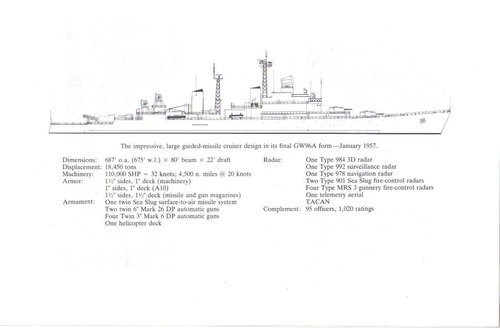Just wondering - the Internet is full of the *1952 carrier* and the far smaller *1954 medium fleet* - bad luck, the closest from the French designs is the *1956* evolution. Is there some kind of name for this one, or is it considered a mere extension of the 1954 "medium fleet carrier" ?
"1956 medium fleet carrier", way to go indeed. I said it before in different threads, but there was a "sweept spot" at 42 000 tons for, altogether - a better Foch, a better Clemenceau, a smaller and least expensive Verdun, plus a trio of British ones, total six carriers.
All this plus the BS-5A catapults, Sea Venom / Aquilons, Colossus / Arromanches, plus a different outcome to the Suez crisis, just scream "joint carriers".
I recently learned that the "Verdun" (just like the "Medium Fleet Carrier", the irony...) also come in two different sizes and two different years.
Basically 1958 PA58 Verdun was 45000 tons, was rejected as too expensive.
The Navy tried again closer from Clem' at 35000 tons the next year (PA59 thus) and this time it was screwed by La Force de Frappe.
What is really interesting is that the Navy (clever boys !) tried to make that third carrier part of the Force de Frappe with a scaled-down naval Mirage IV (the IV-M - here's to you, A-5 Vigilante ) - and failed miserably.
Now with Buccaneers on larger carriers, things might be different. Even more since Etendard IV finally got nukes, except in a tactical role rather than strategic.
Buccaneers even subsonic would do far better - although a lot of teeths would cringe, considering how close it was from the SO-4050 Vautour... rejected in favor of the Mirage IV (those things happens outside the TSR-2 world, too).
So this could be a scenario.
But Buccaneers?
Then again using ATAR is not that big a problem....
Or variants of the Scimitar as we've discussed before.
There was I think the Etendard V, which needed better engines........ a pair of Orpheus perhaps?
A earlier Bristol Transmanche alliance could produce interesting results.
Best way to make it happen: think Bucc S.2 with the Spey.
Let me explain...
The Mirage IV was not always a "twin engine Mirage III" (that is, a French Phantom, the III being the F-104). At the very beginning it was rather like a F-105 - only one big and very powerful engine.
Basically the Mirage IV
- started as a French F-105 (one big engine)
- then morphed into a French Phantom (Mirage IV-C / IV-M)
- then into an A-5 Vigilante (Mirage IV-A as build, except not a naval aircraft)
- And finally, the Mirage IV-B tried to grow into a French B-58 Hustler. that is, a 60 tons medium-range bomber.
What happened was that SNECMA proved unable to build something more powerful than plain old Atar 9. "Super Atar, Vulcain" all went by the window.
At some point the jury split between
- a Vigilante-size 30 mt bomber, too small, but with Atar 9
- a B-58 size 60 mt larger bomber... with foreign engines.
Among the engines considered were
- The Olympus (1959, concorde was 4 years in the future)
- The Iroquois (the Arrow engine)
- the J75 (F-105, F-106) by Pratt&Whitney
And...
- the RB.141 Medway - which bring us to its son - the SPEY
OTL, SNECMA sold their souls and 15% of their shares to Pratt and while we never needed the J75 (since the IV-B was canned) later in 1963 they took a licence on the JTF10 / TF30, the crappy F-111 / Tomcat engine. And they managed to solve the compressor stall plague far better than the Americans: the TF-306 series.
Now, reel back all this to 1959, pick the Medway in place of the J75, and have SNECMA sell themselves to Rolls rather than Pratt.
doesn't change the Medway outcome very much since the Mirage IVB remain too big with foreign engines, not de Gaulle taste.
Still, that 1959 "Medway connection" is far more interesting than the OTL Pratt if only because
- it prepares Concorde Olympus deal by 4 years
- and obviously the Spey is far, far better than that TF30 piece of junk.
- Mirage IV* included, down the road after the TSR-2 die.
Now, if France gets common carriers with the British long before 1959, pushing the Clem's above 40 000 tons, there might be Buccaneers on french carriers, provided that at 42 000 tons they can handle them.
Another area of collaboration (very unexpected) might be Breguet... just like the Buccaneer, the Breguet 941 used BLC. Breguet will love them.












